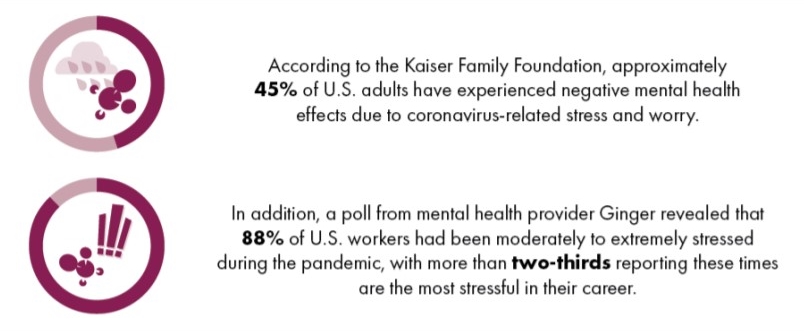According to a Gallup poll, 55% of Americans experience stress daily—making the United States one of the most stressed-out nations in the world. While some stress isn’t necessarily bad for employees’ health, chronic stress can cause negative long-term health effects. Employees will experience stress in all areas of their lives but consistently cite work as their top stressor. In fact, 64% of U.S. adults reported work as their top stressor in 2019.
Workplace stress has a significant impact on employees’ overall well-being. With the majority of Americans reporting their job is stressful, employers must address this issue. Moreover, work-related stress is more strongly associated with illness and health complications than financial or familial stress. Lowering stress can lower the risk of medical conditions and can help employees feel better on a day-to-day basis. While it may not be possible to eliminate job stress entirely for your employees, you can help them learn how to manage it effectively. This toolkit serves as an introduction to workplace stress and provides several ways that employers can address and mitigate stress in the workplace. It is not intended as legal or medical advice and should only be used for informational purposes.
Workplace Stress and the COVID-19 Pandemic
The coronavirus (COVID-19) pandemic has created immense change for employees and employers alike. Whether employees were furloughed, asked to exclusively work from home at short notice, or continue to work throughout the pandemic, this extensive change has caused understandable stress.
In uncertain times such as these, employees are looking for guidance wherever they can find it. Employers can help calm some of their employees’ fears by taking the following actions:
- Acknowledge employee fears surrounding their jobs and the company, but also reassure them of their value to the company and the company’s desire to keep them as members of the team.
- Be open with employees about management decisions and ask for suggestions to rectify problems.
- Provide as much information as possible about the pandemic.
- Highlight employee benefits that employees might not know about to relieve any financial stress.
- Encourage employees to take advantage of any telemental health services to preserve their mental well-being
- Communicate the future of the business with employees often—in meetings, on the company intranet site, in newsletters and in blogs.
- Be empathetic in your communications, as every employee’s situation may be different.
- Be direct and transparent with your company’s return-to-work plans, if applicable, to ensure that employees understand how you will safely have them return to work.
The COVID-19 pandemic is understandably causing uncertainty for employees and their families. Many are trading their normal day-to-day routine for alternative working arrangements. Some employees are also faced with the task of balancing telecommuting and caregiving responsibilities. On top of that, the pandemic situation is fluid, meaning new information is being released daily.
In these uncertain times, it’s imperative that you clearly communicate your business’s plans as frequently as possible. It’s not possible for you to control the pandemic, but it is possible for you to help ease the stress your employees are experiencing.
For More Information about working with your staff, Download the Wellness Toolkit – Stress

